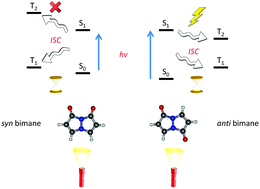Rapid intersystem crossings in anti bimanes†
Abstract
We have carried out first principles electronic structure calculations on the ground and excited valence states of syn and anti bimanes. While syn bimanes fluoresce strongly after photoexcitation to the first excited singlet state (S1) and are commonly used as fluorophores in biological labeling studies, anti bimanes largely phosphoresce at low temperatures. We show that this is due to subtle differences in the energetic ordering of excited singlet and triplet states within the isomers. In particular, T2 in anti bimanes is characterized by a π → π* transition and large exchange interactions with the singlet counterpart cause it to lie below and energetically close to S1 at the Franck–Condon region. This opens up a pathway for very fast intersystem crossing (ca. 1011 s−1) from the optically bright S1 state to the triplet manifold, which effectively quenches fluorescence. On the other hand, T2 is energetically inaccessible to S1 in syn bimanes and intersystem crossing via S1 → T1 cannot compete effectively with fluorescence to S0. We have also located minimum energy conical intersections between S0 and S1 in bimanes. However, these structures are significantly distorted from their equilibrium geometries as well as energetically much higher than S1 at the Franck–Condon region. They are therefore not expected to play a part in the photophysics of bimanes after excitation to S1.


 Please wait while we load your content...
Please wait while we load your content...